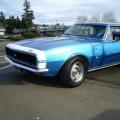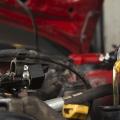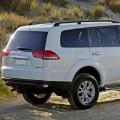9.1. Number of lanes for movement vehicle Determined by markup and (or) signs 5.15.1, 5.15.2, 5.15.7, 5.15.2, 5.15.7, 5.15.8, and if there are no, the drivers themselves, taking into account the width of the roadway, the dimensions of the vehicles and the necessary intervals between them.
Notice - the number of bands is determined by the driver itself, and not the DPS inspector. In fact, traffic cops write their own opinions in the protocol that the road has 4 bands and brazenly accuse the driver in the failure of P 9.1 traffic!
Let us leave this "replacement of the acting person" to the side and begin to count.
According to SNiP 2.05.02-85 " Car roads»The width of the bands is determined by the category of road and can be 3.75 m, 3.5 m, and 3 meters. In Snip 2.07.01-89 (building development), a band of 2.75 for travel is allowed. This is said in P 6.1.3 GUT R 52289-2004 "Rules for the use of road markup": "The width of the locked lane should be at least 3.00 m. It is allowed to reduce the bandwidth intended for movement passenger cars, up to 2.75 m, subject to the introduction of the necessary restrictions of the movement mode. "
Total, with the width of the roadway, the road is less than 12 meters (4 * 3 m) talk about the presence of 4 bands is not just meaningless - you can even challenge in court even the presence of marking! If the necessary restrictions of the motion mode are introduced on the road, the minimum carrier of the carriage part cannot be less than 11 m.
Is there a lot or a little? Width of the VAZ-2110 with mirrors 1.9 m, so 4 cars with a distance of 0.5 meters between them will take 9 meters - that is, the road to 3 bands according to GOST. This is the DPS inspector: four cars will drive? Eat! So 4 bands, it means Article 12.15 - departure to the oncoming. Measure the width of the road and put it in the protocol about administrative offense.
Measure follows the real width of the carriageway without taking into account local extensions on your side of the road, because On the number of bands according to p 9.1 of traffic rules, these broadenings do not affect.
In winter, the road may be narrowed because of snow dumps. Measure the width of the dump before the dump, and not feed the border under them.
If there is a markup on the edges of the roadway, then measure from markup to markup.
In a conversation with IDPs, you should refer to:
1. Decision of the Plenum of the Sun N18 dated October 24, 2006: Community.LiveJournal.com/anti_gibdd/2134.html
a) on the roads with double-sided movement with four bands and more, it is prohibited to leave for overtaking, turning, turning to the side of the road intended for the oncoming movement (paragraph 9.2 of traffic rules). Such a ban must be indicated road markup 1.3;
that is, "there is no markup - there is no violation",
2. Resolution of Sun No. 89-ad07-5 dated 07.24.07.
Tags: If, no, markup, on, road, how, determine, your, strip, movement
Departure to the head of the counter movement, when crossing the solid markup line - is one of the most ...





The rules of PDD are not heard! | Topic author: Eugene


The rules of PDD are not heard!
12.4Onavoda is prohibited:
1 in close proximity to tram pathsif it creates interference by the movement of trams;
2 on railway moving, in tunnels;
3 on overpars, bridges, overpasses (if there are less than three bands for movement in this direction) and under them (regardless of the number of bands);
4 in places where the distance between the stopped vehicle and the solid line of the markup (except the reference part of the roadway) or the opposite edge of the roadway, or standing at the opposite region of the roadway by the vehicle less than three meters, if it creates interference by the movement of vehicles ;
5 on pedestrian crossings and closer than five meters before them;
6 On the roadway of the road near dangerous turns and convex fractures of the longitudinal profile of the road as much as the road less than one hundred meters at least in one direction;
7 at the intersection of the passage parts of the roads and closer to thirty meters from the edge of the intersected roadway of the road, with the exception of the side opposite the side passage of trilateral intersections (crossroads) having a solid line of markup or separation strip; on stopping sites and closer than fifteen meters to them, and when they are absence - closer than fifteen meters from the signpost of stopping vehicles or taxis;
8 in places where the vehicle will close from other drivers traffic lights, road signs or make it impossible to move (entry or departure) of other vehicles, or will create interference to move other vehicles (congestion) and pedestrians;
9 on flowerbeds, lawns, children's and sports grounds. Preface. Extract from traffic rules:
9.1. The number of movement strips for firewood vehicles is determined by markup and (or) signs 5.15.1, 5.15.2, 5.15.7, 5.15.8, and if there are no, then drivers themselves, taking into account the width of the roadway, the dimensions of vehicles and the necessary intervals Between them. At the same time, a party intended for oncoming traffic on the roads with a double-sided movement without a separation strip is considered half the width of the roadway, located on the left, not counting the local spearnesses of the roadway (transition-high-speed stripes, additional stripes on the rise, cash pockets of shutdowns ).
The necessary information for reading this post I allocated fat.
How long have you been riding on the Leningradskaya highway in the area of \u200b\u200bm. Sokol / airport by car?
Roadfall, probably, when applied (nonsense) markups take the basis of paragraph 9.1 of the traffic rules, where black in white it is written that the markups on the road may not be and drivers themselves must determine the lanes.
Indeed, why to read the thick GOST on road marking (GOST R 51256-99) with a bunch of methodologies for verification and control of the quality of drawing markup and with the requirements for it wear resistance at least 3 years? You can simply be scored to apply markup.
Let's see how "lives" markings on the site from home 2 through the Leningrad highway to home 45K1 in Leningradsky Avenue. Round trip.
This is more than 2 ride kilometers drawing roads.
At first I woke up until the summer of 2011, but revised the recording from my registrar, I noticed a stripping difference in the interval of 92 days (3 months - remember this figure) from October 28, 2012 to January 27, 2013.
What happened for these 3 months?
In these 3 months, someone stole the markup on the section 2 of the route kilometer!
1.
I click a larger photo.
On this scheme, the raspberry is the name of the square, which is guaranteed in the field of my vision and about which I can definitely say that there is no markup. But something tells me that the raspberry can be pouring a couple of times more.
Frames of the end of January (click on clicking more larger):
2. This is a place where when moving from the center, markup ends
3. This is one of the widest places on the plot where there is no markup.
Here is the frame of the end of October:
4. The same place where the markup ended in January. We see that it continues.
5. Here is the answer to the question that will be lower in the text.
Where to make a markup? In October, she looked quite well, but in January there was no longer at all.
Can the asphalt shut down? Hmm Later in the fall-winter? In principle, you can only expect from them.
No, we watch two more stoppers: the defects around this hatch are the same. Asphalt did not shift. And there is no markup.
January
6.
October
7.
For those interested - two videos:
January
Ride navigation:
00:12 - Marking disappears
00:29 - One of the widest places
00:40 - Luke
01:24 - Rudimentary markup appears in the tunnel
01:50 - disappears
01:54 - Uukh! Snack. :) She is here for a couple of years, if not more.
01:59 - Marking appears.
October
Everything is simple here, "we are going" and enjoy the markup.
What is this markup that lives 3 months? After all, according to the standards, even the temporary markup should be kept from six months to a year.
And why would I suddenly on the Leningrad highway / prospect temporary markup? Not a rural road which on which you can "by the drivers themselves, taking into account the width of the carriageway, the dimensions of the vehicles and the necessary intervals between them."
Federal route, and for verification - a wide asphalt field without a single markup.
Look at the photo number 3, how much do you "see" the strips for movement? Can you define it on the go taking into account the width and dimensions of vehicles? Me not.
The correct answer is: 6 (six lanes). 6 lanes without marking.
How to navigate? Here the brave roads were presented to motorists an unexpected gift: the generous rut \u200b\u200bof the road. According to these rips, you can easily understand where your row, and where is neighboring.
From what watercolor paint was drawn markup, since it washed it for 3 months in zero?
Even if we assume that in the onset of the new season there will be on this site to shift the asphalt and they knew it in advance, it's still not clear why hundreds of motorists should ride this field at all without any markup?
Similar situation and towards the center.
I will write a perhaps statements in the management of the Falcon areas, the airport and Khoroshevsky. May be told where the markup is done.
UPD February 12, 2013
The control of the airport in response to the application for the cooling markings threatens to restore it. To begin with, I intend to send an appeal to the Balancer GBU "Automobile Roads". These are the most "car roads" of the brave heads of the sections of which they performed the roles of janitors in the plot with Sobyanin: here, here and here.
Let's see when they restore the markup and how much it will last.
Tags: How, orient, on, road, without, marking
Putin allocated 10 billion on creating a unmanned kamaz of the future! Science Technology News Kamaz is preparing ...
9.1. The number of movement strips for firewood vehicles is determined by markup and (or) signs 5.15.1, 5.15.2, 5.15.7, 5.15.8, and if there are no, then drivers themselves, taking into account the width of the roadway, the dimensions of vehicles and the necessary intervals Between them. At the same time, a party intended for oncoming traffic on the roads with a double-sided movement without a separation strip is considered half the width of the roadway, located on the left, not counting the local spearnesses of the roadway (transition-high-speed stripes, additional stripes on the rise, cash pockets of shutdowns ).
Comments Point 9.1.
The traffic strip is called any of the longitudinal bands of the roadway, indicated or not designated by markup and having a width sufficient to move cars in one row.
Design standards set the width of the movement strips and their quantity depending on the category of the road:
- for roads B. settlements from 2.75 m (for secondary passages) to 4.0 m (for pedestrian-transport trunk streets of district meanings)
- outside settlements:
3.75 m for roads I and II categories;
- 3.50 m - for roads III category;
- 3.0 m - for roads IV category.
These values \u200b\u200bare mainly adhered to and when marking a carriageway of roads to the strip. However, retreats from normalized values \u200b\u200bare possible, the causes of which can be:
- informed decisions taken in the development of the project organization project;
- mind of the road with SNiP requirements (which is typical for old roads).
In any case, when applying road marking, the bandwidth in the settlements do:
- not less than 3.0 m for mixed transport flow
- 2.75 m - for the stream of passenger cars.
The extreme right strip can have a width of 4.0-4.5 m if the trolley buses are carried out according to it, and the driving part has a tray with water intake gratings.
If there are no markup and (or) specified signs, the number of travelers for running vehicles is determined by the drivers themselves, taking into account:
- the widths of the roadway;
- vehicle dimensions;
- security intervals between cars.
When determining the movement bands on the road with the missing road markings (or listed in paragraph 9.1 of the characters), it is necessary to begin to define the side of the oncoming movement. To do this, it is necessary to divide cargo part in half. In the presence of:
- overclocking or braking
- country pockets intended for stopping transport vehicles,
- additional strips for lifting
it is necessary to conditionally consider them absent, that is, not to take them into account when determining the side of the counter movement. In other words, you must imagine this section of the road as the "ideal" road on which all the "extra" components listed above are missing above. After that, you must conduct a conditional longitudinal line in the middle of such a road, and half it, located to the left of you, consider the desired "oncoming", the departure of which is punished throughout the rigor of traffic rules.
Note: It is very important to prevent the error towards increasing its side of the roadway. It is fraught with serious consequences, as it can cause a collision with the oncoming vehicle when performing overtaking, turn to the left or reversal. Such division of the carriage part in half is valid for any of its width, including on a 4-5 meter pass. If even the driver visually identified the roadway as a three-wire (9-10.5 m), then in the absence of longitudinal marking, it should alloline only half the width of the carriageway. And the theoretically three-band road is actually two-way - on one wide strip for each direction of movement.
To date, there are hundreds of various rules and norms governing the human activity in various life aspects. Drivers of various vehicles are also required to comply with regulated laws. They are intended to ensure the safety of all the participants in the process and creating an optimal situation for them.
Among the set of norms and laws, each driver needs to be taken into account by several of the most important.
Direction of lanes movement, what is said in traffic rules? Watch the video:
They are presented below:
- Number of bands intended for ride in one direction;
- Which class refers to the used road surface. The driver can move around the city, behind him or in the settlement;
- Bilateral or unilateral movement Installed on the road.
It seems that the definition of these parameters will not require special efforts from the participant roadBut this is possible in the absence of external irritating factors. All sorts of precipitation can significantly impede visibility.
How to determine the number of bands if the markup is not available
Road marking may not be available for the driver's eye. In this case, it is recommended to mentally divide the cloth into two identical parts and move on the right.
Algorithm for determining the lanes
- Sharing a cloth to a couple of identical parts for the distribution of passing and counter vehicles;
- Divide right part on strips, allowing you to easily move the machines;
- Ride in the selected direction at the available part of the road.

How to determine how many stripes on the road. Photo: DS03.infourok.ru.
The main rule is - if there is a central, dividing the track in half, then it is forbidden to cross, as it will make it difficult to move on the oncoming lane and subjected all the participants in the danger movement. Maneuvers are also prohibited.
The minimum amount is five hundred rubles. In this case, the driver does not cross the solid strip, and moved, moving between different parts of the track.
If the driver was completed or on the stripwhich allows only direct motion, It will be necessary to pay a fine from one to one and a half thousand rubles.
If the rules of the road were violated by the cargo vehicleThe size of the fine will be five hundred rubles. In the cities of the federal significance, its volume is increased to five thousand.
Contradictions sign and markup
Sometimes drivers make an erroneous solution due to the occurrence of contradictions of signs and markup.
How to move on the strips to not get a fine? Autoinstructor tips in this video:
- A detour of the repaired portion of the roadway in the opposite;
- When installing marking 1.1 and sign 3.21;
- Overtaking when installing 1.5 and sign 3.2.
Every year there is a tendency to tighten traffic rules. This is a necessary measure.
Each road participant is obliged to follow the rules described. Otherwise it may entail the appearance emergency situations on the road.
Conclusion
Official statistics demonstrate the dynamics of road accidents.
Most cases are associated with the following circumstances:
- Unsuccessful attempt of overtaking Due to late departure to the oncoming lane or intersection of the installed markup;
- Lack of priority bet crossing intersections. On ring and unregulated structures, many accidents accumulate;
- Unsuccessful move In the loaded stream of vehicles.
Each driver moving along the road canvase must be taken into account the order of the lanes.
It is important when crossing various transport junctions and intersections, as well as the implementation of maneuvers of all levels of complexity.
The other day, communicating with a number of drivers, it came across the wall of misunderstanding of the rules of the road at the "wide" roads. This is partly due to the recent changes in traffic rules and the COAP, partly with the fact that the situation was ambiguous to make changes. According to the results of the conversation amounted to a list of 5 ordinary rules.
1. What is a "wide" road?
Under the "wide dear", I understand the road with a double-sided movement consisting of four or more strips. Movement on such roads is dedicated to 9.2 traffic rules. It doesn't matter how many of these strips in one direction, and how much - to another.
That is, the definition that can often hear among the drivers: "At least 2 bands in each direction", - is a delusion: maybe, for example, one strip in one direction and three to another.
It is also an incorrect definition of "2 stripes at least one way", because The road on which 1 strip in one direction and 2 bands to another is suitable for this definition, but is not "broad" in the understanding of which we speak, because There are only three stripes on it, not four.
The number of bands on the road in accordance with clause 9.1 of the traffic control panel is determined by the markup and / or road signs "Direction of Stream Movement" and "Number of Strins". At the same time, according to Appendix No. 2 to the traffic rules in cases where the values \u200b\u200bof signs and markup contradict each other or markup is not distinguishable enough, the drivers must be guided by road signs.
What to do, if no signs, no markup? According to clause 9.1 of traffic rules in this case, the driver determines the number of bands itself, taking into account the width of the carriageway, the dimensions of the vehicles and the necessary intervals between them. Sometimes the driver is beneficial for the road to be less than four bands (see further than the "wide" road differs from the rest). In this case, it must be remembered that according to paragraph 6.1.3 GOST R 52289-2004, the bandwidth, with the exception of special cases, cannot be less than 3 meters. So if you "on the eye" on the road width, say, 13 meters counted 3 bands - it is likely to come down with you, and if you have 2 stripes on the road of a 24 meter width, then almost certainly the judge considers that you are in determining The number of bands were not guided by traffic rules.
2. What is the "wide" road different from the rest?
According to paragraph 9.2 of the traffic control panel "On roads with double-sided movement, having four or more bands, it is prohibited to leave for overtaking or tramp to a strip intended for the oncoming traffic." Regardless of anything, not from markup, no signs (situations with road repair and temporary signs, of course, not in the account). That is, even if you see 4 bands, and the axial line is intermittent, it is impossible to overtake anyway (do not forget that the overtaking is now considered to be ahead with departure to the oncoming lane).
3. So, "double solid meant"?
No, this is a delusion. No markup "meant" can not. Either it is, or it is not.
4. And what about turning to the left and turn?
Before the entry into force of changes in PDD Question Stood acutely, however, at the moment, paragraph 9.2 of the traffic policy is quite specifically regulates this moment: "On such roads, turns to the left or reversal can be performed at the intersections and in other places, where it is not prohibited by the rules, signs and / or marking." That is, if there is no prohibiting reversal or turn to the left markup (as a rule, it is a double solid markup 1.3) and there are no prohibiting turns to the left or reversal signs (usually a sign 4.1.1 "move right") you can safely unfold and rotate left anywhere , regardless of the number of bands. Once again: if you counted 4 lanes, and there are no markings and signs, then it is impossible to overtake on the oncoming lane, but you can unfold.
5. What to do in winter?
Indeed, how to be in winter, when the markings are not visible under the layer of snow, or in the summer, when the markup is hidden under the layer of dirt, or tritely erased? According to paragraph 4.4 of the above-mentioned GOST R 52289-2004 "In areas of roads, where the markup, which determines the mode of movement, is difficult to distinguishable (snow, dirt, etc.) or cannot be restored in a timely manner, set the corresponding signs."
The driver, moving along the snow-covered asphalt, can not know whether there is a prohibition markup. Therefore, in the absence of prohibiting signs, nothing forbids him to turn left or turn. At the same time, of course, care must be taken and be especially attentive.




